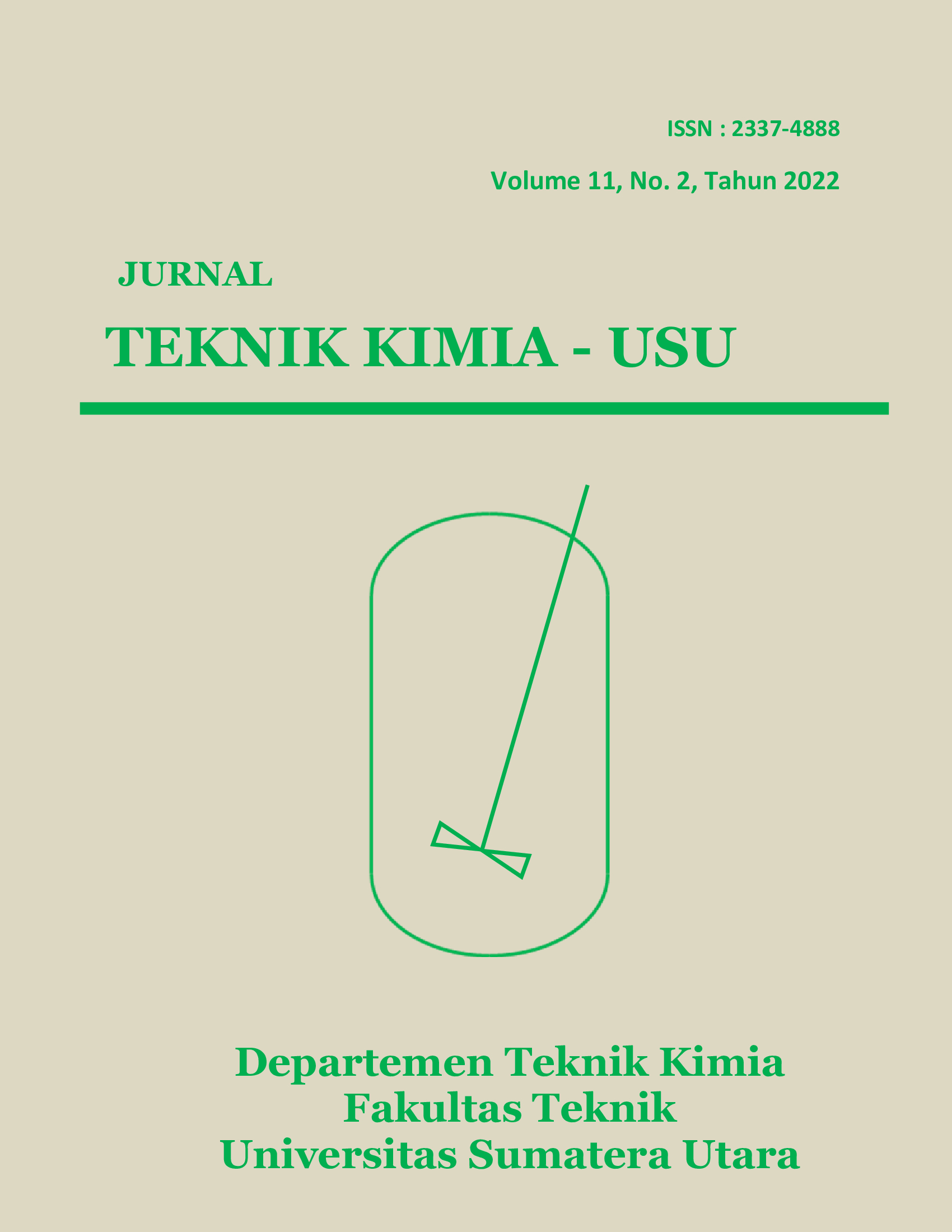Analisis Produksi Biogas Terhadap Penambahan Kulit Singkong pada Variasi Campuran Limbah Cair Domestk dan Aquadest
DOI:
https://doi.org/10.32734/jtk.v11i2.4997Keywords:
domestic liquid waste, cassava peels, biogasAbstract
Domestic waste and agricultural food waste in the form of cassava peels have the potential as a source of raw material for making biogas. This research uses domestic waste from Wastewater Treatment Plant (WWTP) Cemara of Perusahaan Daerah Air Minum (PDAM) Tirtanadi, Sumatera Utara Province. The ratio of domestic waste inoculum from WWTP Cemara PDAM Tirtanadi and water in this study was 100:0, 70:30, 60:40, and 50:50 (v/v). Then, for each variation of the ratio, 3 kg of ground cassava peel was added. This study aims to determine the amount of biogas produced by measuring the pressure in a pipe connected to a bioreactor. The process of making biogas uses anaerobic fermentation with a batch system. The parameter tested in this study is the measurement of the Total Suspended Solid (TSS) value, Volatile Solid (VS) value, pH value, and total Chemical Oxygen Demand (COD) value. From the results of the research conducted, it was found that the variation in the ratio of 100:0 found biogas at a pressure of 205.8 Pa with TSS value of 1348 mg/L, VS value of 410 mg/L, pH value of 7.66 and COD value of 1088 mg/L.
Downloads
References
N. Sumprasit, N. Wagle, N. Glanpracha, and A. P. Annachhatre, “Biodiesel and biogas recovery from Spirulina platensis,†Int. Biodeterior. Biodegrad., vol. 119, pp. 196–204, 2017.
D. T. Allen and D. R. Shonnard, Green Engineering: Environmentally Conscious Design of Chemical Processes. Michigan: Prentice Hall PTR, 2007.
A. Vita, L. Pino, F. Cipitì, M. Laganà , and V. Recupero, “Biogas as renewable raw material for syngas production by tri-reforming process over NiCeO2 catalysts: Optimal operative condition and effect of nickel content,†Fuel Process. Technol., vol. 127, pp. 47–58, 2014.
Q. Zhang, J. Hu, and D. J. Lee, “Biogas from anaerobic digestion processes: Research updates,†Renew. Energy, vol. 98, pp. 108–119, 2016.
B. Salam, S. Biswas, and M. S. Rabbi, “Biogas from mesophilic anaerobic digestion of cow dung using silica gel as catalyst,†Procedia Eng., vol. 105, pp. 652–657, 2015.
Anonim, IEA Bioenergy Annual Report 2015, IEA Bioenergy, Paris, 2015.
T. Al Seadi, D. Rutz, H. Prassl, M. Köttner, T. Finsterwalder, S. Volk and R. Janssen, Biogas handbook, Esbjerg: University of Southern Denmark Esbjerg, 2008.
K. Hagos, J. Zong, D. Li, C. Liu, and X. Lu, “Anaerobic co-digestion process for biogas production: Progress, challenges and perspectives,†Renew. Sustain. Energy Rev., vol. 76, pp. 1485–1496, 2017.
Anonim, “Metode pengujian kadar padatan dalam air,†SNI 06-2413-2002, 2002.
H. Wang, C. Ma, Z. Yang, X. Lu, and X. Ji, “Improving high-pressure water scrubbing through process integration and solvent selection for biogas upgrading,†Appl. Energy, vol. 276, p. 115462, 2020.
Downloads
Published
Issue
Section
License
Copyright (c) 2022 Jurnal Teknik Kimia USU

This work is licensed under a Creative Commons Attribution-ShareAlike 4.0 International License.

















